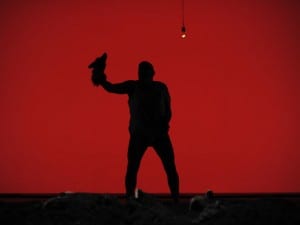Transforming everyday objects into vibrant constructs, Michael Craig-Martin (b. 1941) has shaped the artistic landscape of Britain, both through his own work and his influence on other practitioners, educating many of the YBAs at Goldsmiths College, London. This summer his work adorns the cover of the catalogue for Glyndebourne, running until 25 August. www.glyndebourne.com.
Having lived in a variety of places (Ireland, the USA and Britain), do you find that different locations have made their imprints on your practice?
I feel both a strong sense of belonging and a degree of displacement in all three places; only London feels like home. When I came to Britain 46 years ago, not so many people had experienced that kind of displacement. Today it seems comparatively commonplace, particularly here in London. I know that every place I have lived and worked has had a great impact on what I have done, but I find it impossible to specify exactly how, because I cannot know what I might have done if I had not gone from one country to another.
One of your interests is exploring the expressive potential in everyday objects. What drew you to this?
My interest in ordinary objects was an instinctive choice, not an intellectual or aesthetic one. I do believe that everything of profound importance is available to us through the simplest things around us, but that it is not always easy for us to recognise the truth of what is right in front of us.
Your art spans several decades; do you find there are recurring themes or can you see significant changes in your body of work over time?
The most obvious change in my work occurred after I made An Oak Tree in 1973. Up until that point everything I had done was based in physical objects, and that work was the culmination of that period. Afterwards, and to this day, I have focused on images of objects rather than the objects themselves, primarily through line drawings. These images have proved to be a constantly sustaining source of creative endeavour for me.
As a lecturer at Goldsmiths College you have influenced some incredibly successful artists (Damien Hirst, Michael Landy, Sarah Lucas, Gary Hume). Of these Hirst, in particular, has been commercially successful; what do you think is different about him?
All of the people you mention, and there are many more besides, are very talented. Damien is unusual in that he has produced an exceptionally wide range of work: spot paintings, butterfly paintings, animals in formaldehyde, massive sculptures, works using everything from cigarette butts to diamonds. Each one of these areas might constitute a whole career for another artist. Damien’s work has captured the imagination of people everywhere. The expressive power of the whole range taken together is immense.
One of the major features of your work is colour. Is that a choice based solely on aesthetics or one that has a functional purpose?
The first time I used very intense colours, I was struck by the emotional and physical impact this had on the viewer. I use colour for aesthetic and emotive reasons, as a way of making a general image specific, and as an extension of drawing, for instance to describe changes of material in an object, or the difference between inside and outside.
Your art sometimes involves entire buildings and walls; do you consider architecture when you produce these pieces?
I am fascinated by architecture and also by the possibility of making very large images. The most obvious way to make these is in conjunction with architecture. I always want my work to become a part of the building and not just an added decorative element. My aim with my art is for it to participate in the architecture and alter how people experience it.
How is your work involved with Glyndebourne?
I have designed the catalogue cover and poster for this year’s festival. I wanted it to look sensual and voluptuous, and, in order to achieve this, I worked closely with the printer to produce very rich and vibrant colours. Maybe there will come a day when I will be invited to design an opera.
What do you have planned for the future?
I have a show of new paintings and sculpture at Mies van der Rohe’s Haus Esters in Krefeld this summer, and the Pompidou Centre is showing a large 1994 installation piece in its permanent collection. Next year I will do a comprehensive sculpture show in the extraordinary gardens at Chatsworth. I spend most of my time making drawings, paintings, sculptures and prints, but I find it interesting and refreshing to be asked to do something special: an opera catalogue, an Olympic poster, an immense installation, a postage stamp, a computer work or a portrait. Every time I do something new it opens a door to something else, and I relish this dynamism in what I do.





